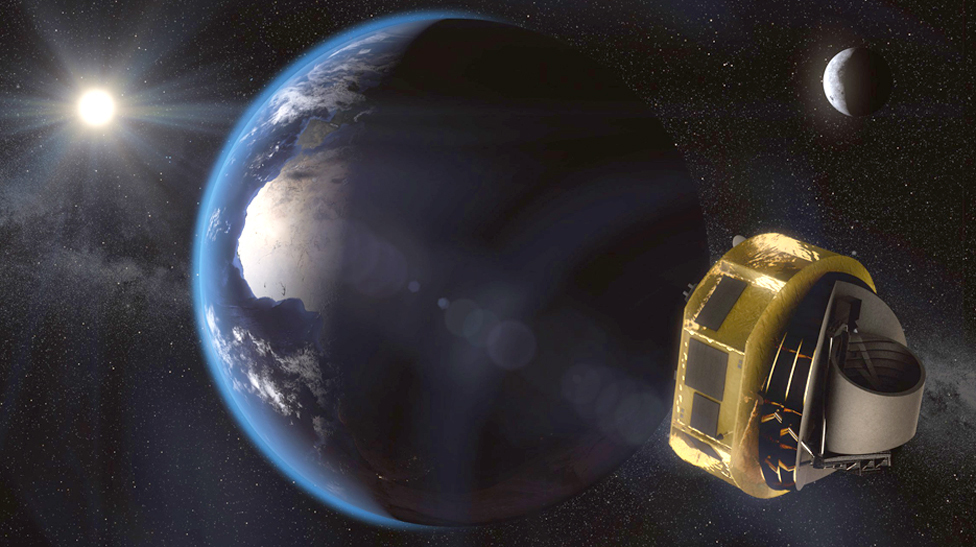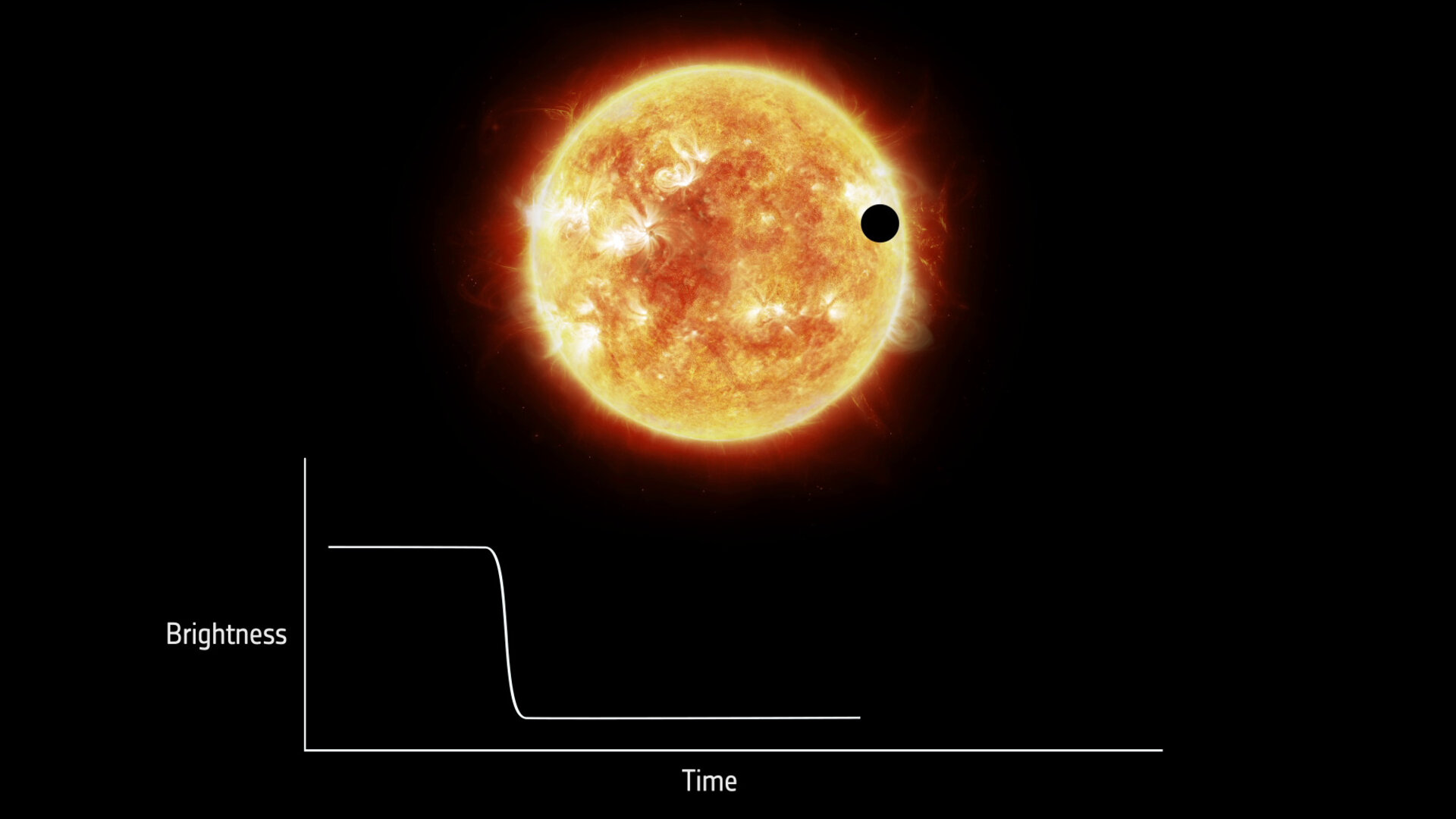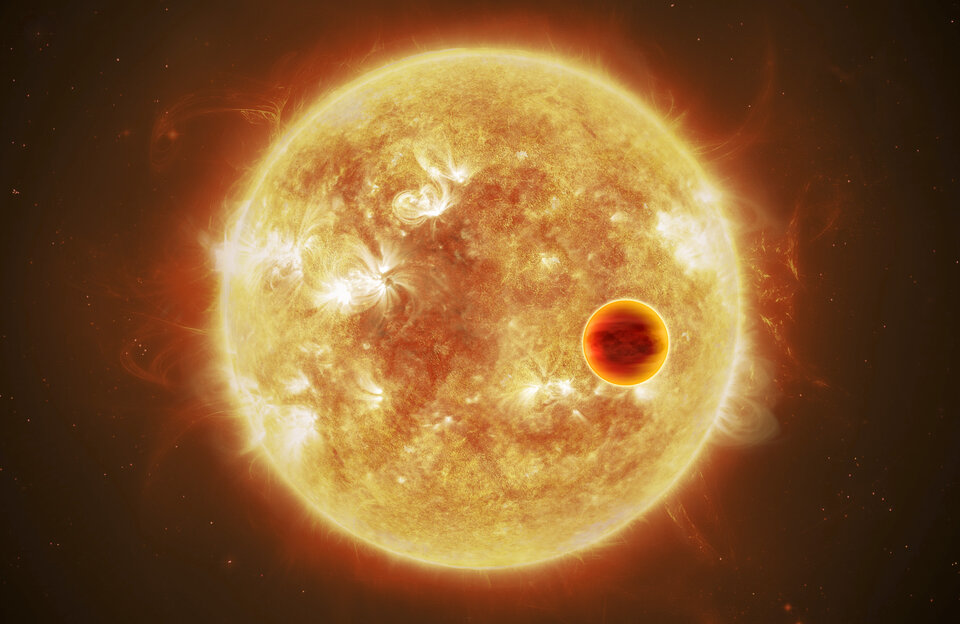27.03.2018

Exoplaneten, also Planeten, die Sonnen anderer Sternensysteme umkreisen, stehen im Mittelpunkt der vierten mittleren Forschungsmission der ESA, die Mitte 2028 gestartet wird.
Ariel, die „Atmospheric Remote‐sensing Infrared Exoplanet Large‐survey mission“ wurde heute von der ESA als Teil ihres Cosmic Vision Programms aufgenommen. Die Mission beschäftigt sich mit einem der Kernthemen von Cosmic Vision: Welches sind die Grundbedingungen für die Bildung von Planeten und die Entstehung von Leben?
Bislang wurden bereits Tausende von Exoplaneten mit verschiedensten Massen, Größen und Umlaufbahnen entdeckt, wobei sich noch kein eindeutiges Muster des Zusammenhanges zwischen der Beschaffenheit der Planeten und des Muttergestirns herauskristallisiert hat. Vor allem müssen wir unsere Wissenslücke schließen, wenn es um die Verknüpfung zwischen der jeweiligen Planetenchemie und der Umgebung, in der sich Planeten bilden, geht oder inwiefern die Art von Muttergestirn die Physik und Chemie der Planetenentstehung beeinflusst.
Ariel wird sich mit den fundamentalen Fragen beschäftigen, woraus Exoplaneten bestehen, wie Planetensysteme sich bilden und weiterentwickeln. Hierzu werden die Atmosphären Hunderter Planeten untersucht, die verschiedene Arten von Muttergestirnen umkreisen. Auf diese Weise können die Unterschiede der Merkmale sowohl bei einzelnen Planeten als auch in Planetengruppen beurteilt werden.
Die Beobachtung dieser Welten wird Einblicke in die frühen Stadien der Entstehung von Planeten und Atmosphären sowie ihre nachfolgende Entwicklung bieten. So können wir Rückschlüsse auf unser eigenes Sonnensystem ziehen.
“Ariel ist der nächste logische Schritt in der Erforschung von Exoplaneten. Sie ermöglicht uns einen weiteren Schritt in der Lösung wissenschaftlicher Kernfragen zur Bildung und Entwicklung dieser Planeten. Gleichzeitig können wir so besser verstehen, welchen Platz unsere Erde im Universum einnimmt”, meint Günther Hasinger, ESA-Direktor für Wissenschaft. “Ariel ermöglicht Wissenschaftlern in Europa in diesem dynamischen Umfeld weiter wettbewerbsfähig zu bleiben. Sie baut auf den Erfahrungen und Kenntnissen aus vorhergehenden Exoplaneten-Missionen auf.”
Ariel wird die Verdunkelung von Sternen mit höchster Präzision messen
Die Mission wird sich auf warme und heiße Exoplaneten konzentrieren – von Super-Erden bis zu Gasriesen –, die in engen Umlaufbahnen ihr Muttergestirn umkreisen. Dadurch profitiert die Mission von den gut gemischten Atmosphären dieser Planeten, um ihre grobe Zusammensetzung zu ermitteln. Ariel wird den chemischen Fingerabdruck der Atmosphären messen, wenn der jeweilige Planet vor seiner Muttersonne vorbeizieht. Dabei wird die Verdunklung mit einer Präzision von 10–100 Millionstel in Bezug zum Stern erfasst.
Neben der Erkennung bekannter Bestandteile, wie Wasserdampf, Kohlendioxid und Methan, wird es auch möglich sein, exotischere Metalle zu ermitteln, die den Planeten in einen Kontext mit dem chemischen Umfeld seines Muttergestirns bringen. Bei einer bestimmten Auswahl von Planeten wird Ariel auch eine Tiefenbeobachtung des Wolkensystems durchführen und saisonale sowie tägliche Veränderungen in der Atmosphäre untersuchen.
Das Teleskop von Ariel arbeitet sowohl im Bereich des sichtbaren Lichts als auch im Infrarotbereich. Es wird Mitte 2028 mit der neuen Ariane 6-Trägerrakete der ESA vom Europäischen Raumhafen in Kourou in den Weltraum geschossen. Seinen Einsatzort für die ersten vier Jahre der Mission nimmt es in einem Orbit etwa am zweiten Lagrange-Punkt, L2, auf, von der Sonne aus betrachtet 1,5 Millionen Kilometer direkt ‘hinter’ der Erde.
Nach der Wahl durch das Komitee für ESA-Wissenschaftsprogramme geht die Mission nun in eine weitere Runde zur detaillierten Untersuchung, um den Aufbau des Satelliten zu definieren. Dies führt dann schließlich zur ‚Annahme‘ der Mission – derzeit für 2020 geplant. Im Anschluss wird ein Auftragnehmer aus der Industrie gesucht, der den Satelliten bauen soll.
Ariel wurde als einer von drei Kandidaten gewählt. Im Wettbewerb standen außerdem die Plasmaphysik-Weltraummission Thor (Turbulence Heating ObserveR) und die Hochenergie-Astrophysik-Mission Xipe (X-ray Imaging Polarimetry Explorer).
Quelle: ESA
----
Update: 14.11.2020
.
Europe moves ahead with Ariel exoplanet mission
The Ariel space telescope, which will study the atmospheres of distant worlds, has the green light to proceed.
European Space Agency (Esa) member states formally adopted the project on Thursday, signing off two years of feasibility studies.
The near-billion-euro observatory is now clear to launch in 2029.
Ariel will probe the gases that shroud exoplanets to try to understand how these objects formed and how they have evolved through time.
The findings are expected to help put the nature of our own Solar System in some wider context.
While it is undoubtedly a grand endeavour for the whole of European space research, Ariel is of particular importance to the UK.
Scientifically, the mission will be led from University College London by principal investigator Prof Giovanna Tinetti. But on the technical front, too, Britain will play a major role.
The "business end" of the observatory - its mirror system and instrumentation - will be assembled and tested at RAL Space on the Harwell Campus in Oxfordshire.
"We're very good at exoplanet research in the UK; we've got one of the largest science communities in the world. So, yes, we want to have a big part in Ariel," said Dr Caroline Harper, the head of science at the UK Space Agency.
"And, of course, in RAL Space we have world-class system engineering, with the expertise and facilities in one place to do the assembly, integration and testing," she told BBC News.

Atmospheric Remote-Sensing Infrared Exoplanet Large-survey
 IMAGE COPYRIGHTESA/STFC RAL SPACE/UCL/EUROPLANET-SCIENCE OFFICE
IMAGE COPYRIGHTESA/STFC RAL SPACE/UCL/EUROPLANET-SCIENCE OFFICE- Launch year: 2029
- Mission lifetime: 4 years
- Payload mass: 500kg
- Launch mass: 1,500kg
Ariel will be despatched to a special observing position that is about 1.5 million km from Earth

The Atmospheric Remote-Sensing Infrared Exoplanet Large-survey (Ariel) telescope was selected as Esa's fourth "Medium Class" mission in its Cosmic Vision series of projects back in 2018.
As is customary, however, member states demanded a period of assessment following this choice to ensure the necessary finances and technology were available to carry the venture through to completion.
Thursday's decision signals that no showstoppers have been identified.
The Ariel consortium will now move forward with the build phase, which will involve the fabrication of various test artefacts, leading eventually to the production of all the flight hardware.
One of the big challenges will be in making an all-aluminium telescope system. This includes the 1.1m by 0.7m primary mirror, which is to be coated in silver.
It's challenging because this system will have to work in space at very low temperatures, at below minus 230C.
"It's the first time they've built quite such a large telescope out of aluminium," said Dr Rachel Drummond, the Ariel national project manager at RAL Space.
"The reason you choose mainly one metal is so it all shrinks together, as it goes cold, so the whole thing stays in focus, even when it's getting smaller.
"When we come to put it into a thermal-vacuum (test) chamber and cool it down to about 40 kelvins, we'll want to see that we don't get any sort of deformation, that things don't bend or move such that the light we're observing isn't actually going into the instrumentation."
Ariel plans to observe up to a 1,000 exoplanets during its main mission phase.
It will do this by watching these worlds as they move in front and behind their host stars. Information about the chemistry of the planets' atmospheres will be imprinted in the starlight coming towards us, and Ariel will extract this detail using its spectroscopic technologies.
RAL Space has a deadline of late 2026 to deliver the science payload.
This will be incorporated into a spacecraft chassis, which will be built either by Thales Alenia Space France or Airbus France. The two aerospace companies are currently in competition and a down-selection to one prime contractor is likely to occur in about a year's time.
Ariel is one of three Esa exoplanet missions. Already launched, last year, is the Swiss-led Cheops telescope, which is refining the size measurement of known worlds (important if you want to say something about the properties of those bodies).
Then comes the Plato space telescope, which is also expected to launch in the second half of the 2020s. Plato's goal is to detect and characterise true Earth-like rocky planets.
The Ariel team says it will have an open science policy whereby data will be made available immediately to the wider science community. It's hoped this will accelerate the insights that emerge from the mission.
"Ariel will enable planetary science far beyond the boundaries of our own Solar System,” said Prof Günther Hasinger, Esa’s director of science. "The adoption of Ariel cements Esa’s commitment to exoplanet research and will ensure European astronomers are at the forefront of this revolutionary field for the next decade and well beyond."
Quelle: BBC
----
Update: 15.11.2020
.
Ariel moves from blueprint to reality
ESA’s exoplanet mission Ariel, scheduled for launch in 2029, has moved from study to implementation phase, following which an industrial contractor will be selected to build the spacecraft.
Ariel, the Atmospheric remote-sensing infrared exoplanet large-survey mission, addresses one of the key themes of ESA’s Cosmic Vision programme: What are the conditions for planet formation and the emergence of life? Ariel will study what exoplanets are made of, how they formed and how they evolve, by surveying a diverse sample of around 1000 planetary atmospheres simultaneously in visible and infrared wavelengths.
It is the first mission dedicated to measuring the chemical composition and thermal structures of exoplanets, linking them to the host star’s environment. This will fill a significant gap in our knowledge of how the planet’s chemistry is linked to the environment where it formed, or whether the type of host star drives the physics and chemistry of the planet’s evolution.
Observations of these worlds will give insights into the early stages of planetary and atmospheric formation, and their subsequent evolution, in the process also helping us to understand how our own Solar System fits into the bigger picture of the overall cosmos.
Ariel was selected in 2018 as the fourth medium-class science mission in ESA’s Cosmic Vision plan. It was ‘adopted’ by ESA during the Agency’s Science Programme Committee meeting on 12 November, paving the way towards construction.
“Ariel will enable planetary science far beyond the boundaries of our own Solar System,” says Günther Hasinger, ESA’s Director of Science. “The adoption of Ariel cements ESA’s commitment to exoplanet research and will ensure European astronomers are at the forefront of this revolutionary field for the next decade and well beyond.”

Ariel will be ESA’s third dedicated exoplanet mission to launch within a ten-year period, with each mission tackling a unique aspect of exoplanet science. Cheops, the CHaracterising ExOPlanet Satellite, launched in December 2019, is already producing world-class science. Plato, the PLAnetary Transits and Oscillations of stars mission, will be launched in the 2026 timeframe to find and study extrasolar planetary systems, with a special emphasis on rocky planets around Sun-like stars in the habitable zone – the distance from a star where liquid water can exist on a planet’s surface. Ariel, planned to launch in 2029, will focus on warm and hot planets, ranging from super-Earths to gas giants orbiting close to their parent stars, taking advantage of their well-mixed atmospheres to decipher their bulk composition.
In the coming months, industry will be asked to make bids to supply spacecraft hardware for Ariel. Around summer next year, the prime industrial contractor will be selected to build it.
The mission’s payload module, which includes a one metre-class cryogenic telescope and associated science instruments, is provided by the Ariel Mission Consortium. The consortium comprises more than 50 institutes from 17 European countries. NASA also contributes to the payload.
“After an intensive period working on the preliminary design concepts and on the consolidation of the required technologies to demonstrate the mission feasibility, we are ready to move Ariel forward to the implementation stage,” says ESA’s Ariel study manager Ludovic Puig.


Access the video
The telescope’s spectrometers will measure the chemical fingerprints of a planet as it crosses in front of – ‘transits’ – its host star, or passes behind it – an ‘occultation’. The measurements will also enable astronomers to observe the dimming of the host star by the planet with a precision of 10–100 parts per million relative to the star.
Ariel will be able to detect signs of well-known ingredients in the planets’ atmospheres such as water vapour, carbon dioxide and methane. It will also detect more exotic metallic compounds to decipher the overall chemical environment of the distant solar system. For a select number of planets, Ariel will also perform a deep survey of their cloud systems and study seasonal and daily atmospheric variations.

“With Ariel we will take exoplanet characterisation to the next level by studying these distant worlds both as individuals and, importantly, as populations, in much greater detail than ever before possible,” says ESA’s Ariel study scientist Göran Pilbratt.
“Our chemical census of hundreds of solar systems will help us understand each planet in context of the chemical environment and composition of the host star, in turn helping us to better understand our own cosmic neighbourhood,” adds ESA’s Ariel project scientist Theresa Lueftinger.
“We’re pleased to enter the implementation phase of the Ariel mission,” says ESA’s Ariel project manager Jean-Christophe Salvignol. “We’re moving towards the optimal spacecraft design for answering fundamental questions about our place in the cosmos.”
Ariel is planned for launch on ESA’s new Ariane 6 rocket from Europe’s spaceport in Kourou, French Guiana. It will operate from an orbit around the second Sun-Earth Lagrange point, L2, 1.5 million kilometres directly ‘behind’ Earth as viewed from the Sun, on an initial four-year mission. The ESA-led Comet Interceptor mission will share the ride into space.
Quelle: ESA
----
Update: 16.11.2020
.
UK-led space telescope to unravel mysteries of the cosmos
The European Space Agency has given the green light to the world’s first space telescope dedicated to studying how exoplanet atmospheres form and evolve

Its mission is to understand the links between a planet’s chemistry and its environment by charting approximately 1,000 known planets outside our own Solar System, arming scientists with a full picture of what exoplanets are made of, how they were formed and how they will evolve.
The Atmospheric Remote-sensing Infrared Exoplanet Large-survey, or Ariel as it’s better known, has been put through a rigorous review process throughout 2020, and is now slated for launch in 2029.
Thanks to government funding through the UK Space Agency, UK research institutions – including UCL, the Science and Technology Facilities Council’s (STFC) RAL Space, Technology Department and UK Astronomy Technology Centre, Cardiff University and University of Oxford – are playing a critical role in the mission; providing leadership, contributing expertise, vital hardware and software and shaping its goals.
Once in orbit, Ariel will rapidly share its data with the general public – inviting space enthusiasts and budding astronomers to use the data to help select targets and characterise stars.
Science Minister Amanda Solloway said:
Thanks to government funding, this ambitious UK-led mission will mark the first large scale study of planets outside the Solar System, and will enable our leading space scientists to answer critical questions on their formation and evolution.
It is a testament to the brilliant work of the UK space industry, our incredible scientists and researchers led by University College London and RAL Space and our international partners that this mission is ‘lifting off’. I look forward to watching it progress towards launch in 2029.
The spectrographs aboard the observatory will study the light that filters through a planet’s atmosphere as it passes — or transits — across the face of its host star, revealing chemical fingerprints of gases that shroud the body.
The instruments will also try to refine estimates of a planet’s temperature by teasing out how light from its star changes when the body moves behind it, revealing details about a planet’s overall radiation budget.
Ariel will be able to detect signs of well-known ingredients in the planets’ atmospheres such as water vapour, carbon dioxide and methane. It will also detect more exotic metallic compounds to decipher the overall chemical environment of the distant solar system. For a select number of planets, Ariel will also perform a deep survey of their cloud systems and study seasonal and daily atmospheric variations.

An example spectrum Ariel could measure from light passing through an exoplanet's atmosphere (ESA/STFC RAL Space/UCL/UK Space Agency/ATG Medialab)
Professor Giovanna Tinetti, Principal Investigator for Ariel from University College London said:
We are the first generation capable of studying planets around other stars. Ariel will seize this unique opportunity and reveal the nature and history of hundreds of diverse worlds in our galaxy. We can now embark on the next stage of our work to make this mission a reality.
Some 4,374 worlds have been confirmed in 3,234 systems since the first exoplanet discoveries in the early 1990s.
This mission will focus on planets unlikely to host life as we know it - from extremely hot to temperate, from gaseous to rocky planets orbiting close to their parent stars, and a range of masses, in particular those heavier than a few Earth masses.
An advantage of studying hot planets is that their atmospheres usually reflect the body’s overall composition, whereas cooler planets’ chemicals can condense into clouds high in the atmosphere, therefore hiding details of the chemistry at lower altitudes from our view.
Ariel Consortium Project Manager, Paul Eccleston, of STFC RAL Space, said:
This represents the culmination of lots of preparatory work by our teams across the world over the last five years in order to demonstrate the feasibility and readiness of the payload. We now go full speed ahead to fully develop the design and start building prototypes of the instrumentation on the spacecraft.
Historically scientists have tended to focus on planets that could harbour life. But the diversity of exoplanet types and systems revealed by studies so far — and the growing realisation that our own system may be atypical — make understanding the bigger picture that much more important.
Quelle: UK Space Agency
